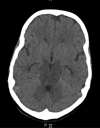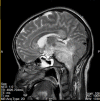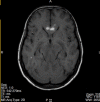Weston-Hurst syndrome: a rare fulminant form of acute disseminated encephalomyelitis (ADEM)
- PMID: 27797801
- PMCID: PMC5073582
- DOI: 10.1136/bcr-2016-217215
Weston-Hurst syndrome: a rare fulminant form of acute disseminated encephalomyelitis (ADEM)
Abstract
A 25-year-old Pakistani woman presented to the emergency department with a 2-day history of rapidly progressive tetraplegia followed by sudden loss of consciousness. This was preceded by an upper respiratory tract infection. On examination, she was deeply comatose with a GCS of 3/15 and intact brainstem reflexes. She was in respiratory distress, and an endotracheal tube had been passed. She had flaccid quadriplegia with depressed deep tendon reflexes and upgoing plantar response. Her MRI brain with contrast showed extensive brainstem involvement with haemorrhagic foci along with signal changes in the corpus callosum. The patient was put on a respirator. She was given IV methyl prednisolone, and later on 5 sessions of plasmapheresis were performed. After 3 months, the patient gradually recovered and started communicating. Her motor power had improved to 2/5 in her arms and 1/5 in the lower extremities. She was then discharged for further rehabilitation at home.
2016 BMJ Publishing Group Ltd.
Conflict of interest statement
Conflicts of Interest: None declared.
Figures





References
-
- Donnet A, Dufour H, Gambarelli D et al. . Acute Weston Hurst necrotizing hemorrhagic leukoencephalitis. Rev Neurol (Paris) 1996;152:748–51. - PubMed
Publication types
MeSH terms
LinkOut - more resources
Full Text Sources
Other Literature Sources
